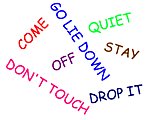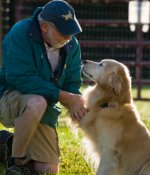Australian Terriers: What's Good About 'Em, What's Bad About 'Em
Australian Terrier temperament, personality, training, behavior, pros and cons, advice, and information, by Michele Welton, Dog Trainer, Behavioral Consultant, Author of 15 Dog Books
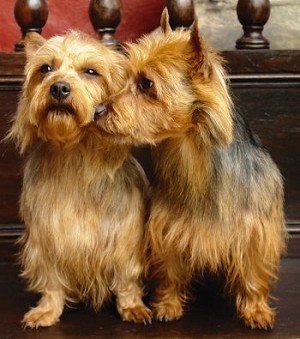
The AKC Standard calls him "spirited, alert, courageous, and self-confident, with the natural aggressiveness of a ratter and hedge hunter."
One of the most sensible of the terriers, the Australian is nonetheless as hardy and spunky as the rest.
To live happily with an Aussie (or any other terrier), you should fit certain criteria. You should understand the dynamic terrier temperament. You should have a fenced yard. And you should be able to provide sufficient daily companionship (no working all day), daily walks, and daily play sessions with a ball or toy.
Though small, the Australian Terrier is an alert watchdog with keen senses. Most individuals are reserved/polite with strangers.
Like all terriers, Aussies can be scrappy with other dogs of the same sex. But most individuals are willing to coexist peacefully with other pets. They can be bossy, though! And they're bred to pursue anything that runs or looks like prey, so keeping a pet hamster or rat would be a big risk!
Quick to learn, an Aussie is mostly willing to please, though he definitely has his independent moments and must be taught who is in charge.
As befits their heritage, some Australian Terriers are born diggers. Some can be barky, though in general this breed is quieter than many other terriers.
If you want a dog who...
- Is small, yet tough and sturdy – not a delicate lapdog
- Has a natural appearance
- Is one of the healthiest breeds, with fewer genetic defects than most other terriers
- Needs only moderate exercise (but definitely a fenced yard)
- Makes a keen watchdog
- Doesn't shed too much (but is not "hypoallergenic")
- Co-exists with other pets more willingly than some other terriers
An Australian Terrier may be right for you.
If you don't want to deal with...
- The dynamic terrier temperament (see full description below)
- Providing enough exercise and activities to keep them busy
- Chasing smaller animals
- Stubbornness
- Digging holes
- Barking
- Regular brushing and clipping of the wiry coat
- Waiting lists (hard to find)
An Australian Terrier may not be right for you.
 |
Dog Breed Traits – Which Traits Are Right For You? In this brand new series, I'll help you decide which dog breed traits would best suit you and your family, your home and yard, and your lifestyle, so you can choose the best dog breed for your family. |
Keep in mind that the inheritance of temperament is less predictable than the inheritance of physical traits such as size or shedding. Temperament and behavior are also shaped by raising and training.
FREE eBooks by Michele Welton
![]() "Respect Training for Puppies" and "Teach Your Dog 100 English Words" are free step by step guides to teaching your pup to be calm and well-behaved.
"Respect Training for Puppies" and "Teach Your Dog 100 English Words" are free step by step guides to teaching your pup to be calm and well-behaved.
![]() "11 Things You Must Do Right To Keep Your Dog Healthy and Happy" is a free guide to keeping your dog mentally, physically, and emotionally happy and healthy so you can enjoy a longer lifetime of companionship.
"11 Things You Must Do Right To Keep Your Dog Healthy and Happy" is a free guide to keeping your dog mentally, physically, and emotionally happy and healthy so you can enjoy a longer lifetime of companionship.

- You can avoid some negative traits by choosing an ADULT dog from an animal shelter or rescue group. With an adult dog, you can easily see what you're getting, and plenty of adult Aussies have already proven themselves not to have negative characteristics.
- If you want a puppy, you can avoid some negative traits by choosing the right breeder and the right puppy.
More traits and characteristics of the Australian Terrier
If I was considering an Australian Terrier, I would be most concerned about...
- The dynamic terrier temperament. Most terrier breeds are remarkably similar. The same words are used over and over – quick to bark, quick to chase, lively, bossy, feisty, scrappy, clever, independent, stubborn, persistent, impulsive, intense. But some terrier breeds are more so than others. Overall, as a breed, Australian Terriers tend to be in the lower-to-middle section of the terrier spectrum. But of course there are some individual Aussies who will be in the higher end!
- Providing enough exercise and mental stimulation. I recommend that you get your Australian Terrier involved in regular obedience classes at the intermediate or advanced level, or in ongoing agility classes (an obstacle course for dogs). Or join an earth dog club, where terriers are encouraged to dig and tunnel after small critters (which are secured in a sturdy cage so they can't be harmed).
- Potential animal aggression. Australian Terriers are less scrappy toward other animals than many other terrier breeds. They usually live peacefully with the other pets in their own family. But they are still a determined force to reckon with if they decide to initiate or accept a challenge to fight.
- Yard security. Terriers need a fenced yard in which to stretch their legs, but many terriers are clever escape artists who will go over or under fences in search of adventure. You may need higher fences than you might imagine for their small size. You may also need to sink wire into the ground along the fence line to thwart digging.
- Running away from you. Like all dogs, Australian Terriers must be taught to come when called. But I would only count on this breed obeying his training in an enclosed area. Terriers should not be trusted off-leash. The risk is too great that they will take off after anything that runs, oblivious to your frantic shouts.
- Barking. Terriers are often too quick to sound the alarm at every new sight and sound. You have to be equally quick to stop them.
- Mind of their own. Though more amenable to training than many other terriers, Australian Terriers must be taught at an early age that they are not the rulers of the world. The toughness that makes them suited to killing vermin can frustrate you when you try to teach them anything. Terriers can be stubborn and dominant (they want to be the boss) and will make you prove that you can make them do things. Read my free online training programs.
- Potential defensive reactions. If you need to physically chastise a terrier, and you go beyond what THEY believe is a fair correction, terriers (as a group) are more likely than other breeds to growl or snap. As an obedience instructor, I'm always extra careful when putting my hands on a terrier for a correction.
I do not recommend terriers for small children. Many terriers will not tolerate any nonsense from little life forms whom they consider to be below themselves in importance. Many terriers are quick to react to teasing, and even to the normal clumsiness that comes with small children (accidental squeezing of their ears or pulling of whiskers or stepping on their paw). Many terriers are possessive of their food and toys and will defend these from all comers, including children.
- Grooming. Australian Terriers require clipping and trimming every few months. Breed purists may say that terrier coats should never be clipped because it makes the coat softer and more prone to matting. Instead they advocate hand-stripping (each dead hair pulled out so a new one can grow in its place). But in my opinion, stripping is too time-consuming and uncomfortable for the dog. Many groomers won't do it anymore. For pet dogs, I think clipping is just fine.
My best-selling books – now available FREE on my website
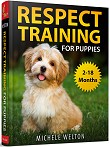 Respect Training For Puppies: 30 seconds to a calm, polite, well-behaved puppy is for puppies 2 to 18 months old. Your puppy will learn the 21 skills that all family dogs need to know. Click here to read for free.
Respect Training For Puppies: 30 seconds to a calm, polite, well-behaved puppy is for puppies 2 to 18 months old. Your puppy will learn the 21 skills that all family dogs need to know. Click here to read for free.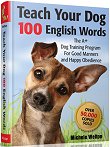 Teach Your Dog 100 English Words is a unique Vocabulary and Respect Training Program that will teach your adult dog to listen to you and do what you say. Click here to read for free.
Teach Your Dog 100 English Words is a unique Vocabulary and Respect Training Program that will teach your adult dog to listen to you and do what you say. Click here to read for free.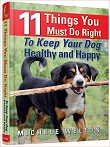 11 Things You Must Do Right To Keep Your Dog Healthy and Happy helps your dog live a longer, healthier life. Get my honest advice about all 11 Things before you bring home your new puppy, because some mistakes with early health care cannot be undone. Click here to read for free.
11 Things You Must Do Right To Keep Your Dog Healthy and Happy helps your dog live a longer, healthier life. Get my honest advice about all 11 Things before you bring home your new puppy, because some mistakes with early health care cannot be undone. Click here to read for free.Related posts you might enjoy





